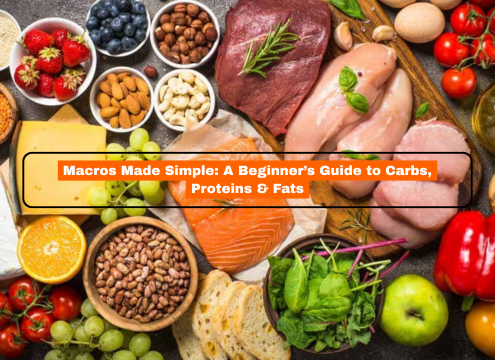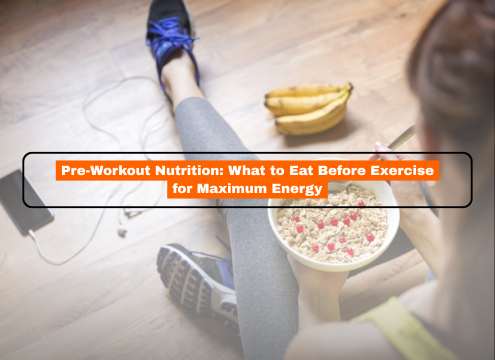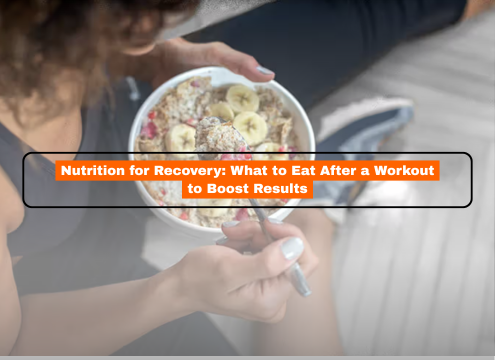If you’ve ever started a fitness journey, tried to eat healthier, or even Googled “how to lose weight,” you’ve probably come across the term macros—short for macronutrients.
At first, it can sound overwhelming. Carbs? Proteins? Fats? How much of each? Should you cut carbs or go keto? Add more protein? Avoid fats?
Breathe. Let’s break it down—no diets, no fluff, just real, useful information.
In this guide, we’ll simplify macros so you can build a balanced diet that fuels your goals—whether that’s losing weight, gaining muscle, or just feeling your best.
💡 What Are Macros?
Your body need the three important macronutrients in significant quantities to function. These are Carbohydrate, protein and fats, all three of them has a distinct function in your body and they are all necessary for good health. Whereas macronutrients supply calories (energy), micronutrients (vitamins and minerals) do not.
Here’s what each macro does, where to find them, and how to use them wisely.
🍞 Carbohydrates: Your Body’s Main Energy Source
What They Do:
Carbohydrates (carbs) are your body’s primary fuel, especially for your brain and during exercise. When you eat carbs, your body breaks them down into glucose (sugar), which is used for immediate energy or stored as glycogen in your liver and muscles.
Why You Need Them:
- Fuel high-intensity workouts
- Support brain and nervous system function
- Regulate digestion (thanks to fiber!)
- Provide satiety and mood stability
Types of Carbs:
Not all carbs are created equal. They’re typically divided into two main categories:
1. Simple Carbs (Quick energy, but short-lived)
- Found in: sugar, candy, white bread, pastries
- Cause quick spikes (and crashes) in blood sugar
2. Complex Carbs (Sustained energy + nutrients)
- Found in: whole grains, vegetables, legumes, fruits
- Rich in fiber, slower to digest = more stable energy
Best Choices:
- Oats
- Quinoa
- Sweet potatoes
- Brown rice
- Whole fruits
- Legumes
Tip: Avoid cutting carbs completely. Instead, choose high-fiber, nutrient-dense carbs to fuel your workouts and support metabolism.
🍳 Proteins: The Building Blocks of Life
What They Do:
Protein isn’t just for bodybuilders. It’s a structural nutrient that helps build and repair tissues, make hormones and enzymes, and maintain a strong immune system.
Why You Need It:
- Builds and repairs muscles (especially after exercise)
- Supports immune function and hormone balance
- Keeps you full longer (reduces cravings)
- Essential for hair, nails, and skin health
Protein Quality:
Proteins are made of amino acids. Your body can make some, but 9 essential amino acids must come from food.
1. Complete Proteins (contain all 9 essential AAs)
- Eggs, fish, chicken, dairy, soy, quinoa
2. Incomplete Proteins (combine for balance)
- Lentils + rice
- Chickpeas + whole wheat
- Tofu + grains
Best Sources:
- Lentils and legumes
- Tofu and tempeh
- Eggs
- Greek yogurt
- Paneer
- Chicken, fish
- Protein shakes (whey, plant-based)
Tip: Spread protein across meals to maximize muscle repair and fullness. Aim for ~20–30g per meal.
🥑 Fats: The Unsung Heroes of Health
What They Do:
For years, fats were wrongly vilified. But your body needs fats—especially the healthy kind. They promote hormone production, cognitive function, and the absorption of fat-soluble vitamins (A, D, E, and K).
Why You Need Them:
- Help absorb nutrients
- Support brain and nerve health
- Maintain healthy skin and hormones
- Provide long-lasting energy
Types of Fats:
1. Healthy Fats (Monounsaturated + Polyunsaturated)
- Olive oil
- Avocados
- Nuts and seeds
- Fatty fish (like salmon)
2. Unhealthy Fats (Trans fats, excess saturated fats)
- Found in fried foods, processed snacks, baked goods
- Can increase risk of heart disease
Best Choices:
- Walnuts, almonds, flaxseeds, chia seeds
- Avocados
- Extra virgin olive oil
- Nut butters (peanut, almond—if tolerated)
- Ghee (in moderation)
Tip: Fat is calorie-dense, so portion control matters—but don’t fear fat. It’s essential, especially for women’s hormone balance.
📊 How to Balance Your Macros
Now that you know what each macro does, how do you put them together?
There’s no one-size-fits-all answer. Your ideal macro ratio depends on your goals, lifestyle, age, and activity level. But here are some general starting points:
💪 For Fat Loss:
- 40% carbs / 30% protein / 30% fat
- Prioritize protein to preserve muscle and stay full
- Moderate carbs for energy
- Include healthy fats to stabilize hormones
🏋️ For Muscle Gain:
- 45% carbs / 30% protein / 25% fat
- More carbs to fuel lifting and build mass
- Protein for recovery and repair
- Fats for hormonal health
🤸♀️ For General Wellness:
- 45–50% carbs / 25–30% protein / 20–30% fat
- Balanced intake for energy, brain function, and immune support
You can track macros using apps like MyFitnessPal or Cronometer, or use your hand as a visual guide:
- Protein = palm-sized
- Carbs = cupped hand
- Fats = thumb-sized
🧠 Mindful Macro Tips
- Quality over quantity: Always choose whole food sources of macros. A donut and an apple both have carbs, but one fuels you, the other depletes you.
- Hydrate too: Water doesn’t count as a macro, but it’s vital. Dehydration affects energy, hunger, and digestion.
- Don’t obsess: You don’t have to count every gram forever. Learn the basics, apply the principles, and find what feels good for your body.
- Adjust with life: Your needs change with activity, stress, hormones, sleep, and goals. Listen to your body and stay flexible.
📋 Sample Balanced Day
Here’s how a macro-balanced day might look:
🥣 Breakfast:
- Oats with chia seeds, banana, and Greek yogurt
→ Carbs + Protein + Fat
🍛 Lunch:
- Brown rice, dal, sautéed veggies in ghee
→ Carbs + Protein + Fat
🥜 Snack:
- Boiled eggs or hummus with veggie sticks
→ Protein + Fat
🍲 Dinner:
- Grilled tofu, quinoa, stir-fried greens with olive oil
→ Protein + Carbs + Fat
🔄 Macros vs. Calories: What’s More Important?
Think of calories as the quantity and macros as the quality.
- You can eat 1500 calories of junk and still feel tired, hungry, and flabby.
- Or eat 1500 calories of well-balanced macros and feel strong, full, and energized.
Bottom line: Both matter—but for real body composition changes and health, macro quality > calorie quantity.
✅ Final Takeaway: Macros Made Simple
Gaining an understanding of macros is about empowerment, not being compulsive. Knowing how carbs, proteins, and fats work allows you to make informed, intentional food choices that fuel your goals.
- Carbs = Energy
- Proteins = Repair & Growth
- Fats = Hormones & Brain Power
When you balance all three, you unlock steady energy, better workouts, faster recovery, and long-term health.
🌟 Final Words:
Ditch the diet drama. Pay attention to your body, balance your plate, and have fun.
Because being physically healthy is about nourishing your life, not about following rules.





